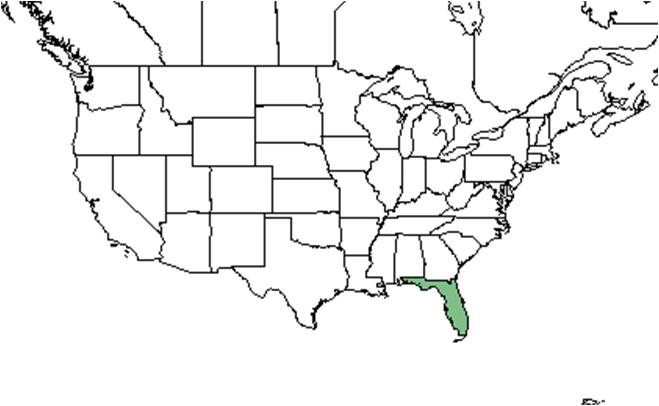Paronychia chartacea
| Paronychia chartacea | |
|---|---|
Error creating thumbnail: Unable to save thumbnail to destination
| |
| Photo by Shirley Denton (copyrighted, use by photographer’s permission only), Atlas of Florida Vascular Plants | |
| Scientific classification | |
| Kingdom: | Plantae |
| Division: | Magnoliophyta - Flowering plants |
| Class: | Magnoliopsida – Dicotyledons |
| Order: | Caryophyllales |
| Family: | Caryophyllaceae |
| Genus: | Paronychia |
| Species: | P. chartacea |
| Binomial name | |
| Paronychia chartacea Fernald | |

| |
| Natural range of Paronychia chartacea from USDA NRCS Plants Database. | |
Common name: paper nailwort
Contents
Taxonomic notes
Description
A description of Paronychia chartacea is provided in The Flora of North America.
Distribution
There are two isolated subspecies of P. chartacea. P. chartacea ssp. chartacea can be found in scrub habitats of the Florida peninsula, this subspecies has been observed as a short-lived perennial. P. chartacea ssp. minima is found in the karst region of the northwest Florida panhandle, it has been described as somewhat less pubescent than P. chartacea ssp. chartacea, and is annual subspecies [1][2]. Much of the distinction between the two subspecies is minimal (Anderson 1991).
Ecology
Habitat
FSU Herbarium specimen have documented P. chartacea to be found in sand pine scrubs with Hypericum cumulicola, herbarium labels do not specify what subspecies these specimen are. It can be inferred that the individuals growing in this habitat are of P. chartacea ssp. chartacea based on previous knowledge of the distribution of the two subspecies. P. chartacea ssp. chartacea is restricted to the Lake Wales Ridge in Highlands, Polk, Osceola, Orange and Lake Counties. Within this range, it is found growing in sand pine scrubs and Florida rosemary scrubs[2]. Soils of this area include those of St. Lucie and Archbold soil types (Abrahamson et al. 1984). It is a gap specialist, occurring at greater densities in areas of open bare sand, and is one of the most abundant species in the rosemary scrub seedbank (Schafer et al. 2010).
P. chartacea ssp. minima is found in nearly pure stands in the karst region of the Florida panhandle (Washington and Bay counties). It has been observed growing with Amphicarpum muhlenbergianum, Bulbostylis barbata, B. ciliatifolia, Chrysopsis lanuginosa, Eriocaulon lineare and Hypericum lissophloeus [2].
Phenology
Flowers August through November and fruits in October (FSU Herbarium).
Seed dispersal
Seed bank and germination
Germination of P. chartacea ssp. chartacea is highest in intact scrubs because invertebrate predators may use the low shrub cover of the rosemary scrubs to hide from carnivorous predators which are less likely to forage in degraded scrubs(Stephens et al. 2012). Schafer et al. 2010 found it to be one of the most abundant species in the rosemary scrub seedbank. It is an annual and obligate seeder with germination frequency increasing post-burn (Weekley and Menges 2003). Seedlings have been observed to germinate over a broad range of months (Hawkes and Menges 2003).
Fire ecology
Pollination
The following Hymenoptera families and species were observed visiting flowers of Paronychia chartacea at Archbold Biological Station (Deyrup 2015):
Halictidae: Lasioglossum miniatulus, L. nymphalis, L. placidensis
Pompilidae: Anoplius semirufus, Episyron conterminus posterus
Sphecidae: Tachysphex apicalis, T. similis
Vespidae: Leptochilus krombeini, Parancistrocerus salcularis rufulus
Use by animals
Diseases and parasites
Conservation and Management
Cultivation and restoration
Photo Gallery
References and notes
Deyrup, M.A. and N.D. 2015. Database of observations of Hymenoptera visitations to flowers of plants on Archbold Biological Station, Florida, USA.
Florida State University Robert K. Godfrey Herbarium database. URL: http://herbarium.bio.fsu.edu. Last accessed: October 2015. Collectors: Loran C. Anderson, Wilson Baker, L.J. Brass, Angus Gholson, Robert K. Godfrey, Ann Johnson, Beverly Judd, Walter Judd, Olga Lakela, Eric S. Menges, Susan Wallace, D.B. Ward. States and Counties: Florida: Bay, Highlands, Polk, Washington. Compiled by Tall Timbers Research Station and Land Conservancy.